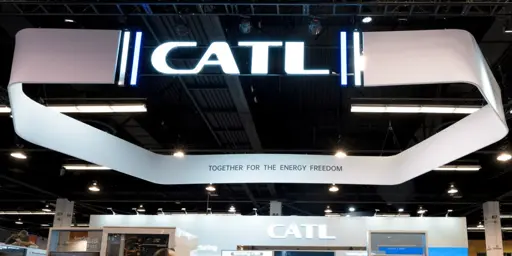This is important for a few reasons. These batteries cost less because they don’t rely on lithium. Sodium is extremely abundant and takes little energy to mine and refine. But more importantly, they last much longer and they work in very cold temperatures.
And I’ll believe it when I see it, rather than a press release of promises which is basically a paid ad to hitch investors.
This kind of disinterested cynicism is toxic.
You can buy sodium batteries from this company, right now, on Alibaba.
They’re the world’s biggest battery manufacturer, that’s like doubting Samsung when they talk about the feature of their next smartphone.
I’m not that tech savvy: what is the average Li-ion density?
This is from memory, but i think it’s approximately accurate, especially in relations to each other:
Li-ion have 280-320 Wh/kg but they have the disadvantage that they’re explosive. If you get in an accident and the battery gets damaged, it explodes rather violently, and you don’t want that for safety reasons.
Then there’s LFP batteries which also contain Lithium as the main ingredient, but they have the advantage that they don’t explode when they’re damaged. They have 220-250 Wh/kg.
Then there’s Na-ion, which also have the advantage of not exploding when damaged, and they have 160 Wh/kg (depending on type, new types with better energy density are being actively researched right now). They have the additional advantage of not containing Lithium (Li), instead they contain Sodium (Na), which is significantly cheaper and more widely available worldwide. So the batteries have the prospect of being much cheaper, especially if produced in large scales, and that’s really the main advantage they have.
It’s not so much about Wh/kg for stationary applications (like grid stabilization or home storage), instead it’s about Wh/$, i.e. how much storage capacity you get per dollar. And that is significantly higher for Na-ion than for Li-ion or LFP.
A tank of gasoline is far more likely to explode with 10x more energy.
Unfortunately I can’t seem to refill my tank by passing in excess electricity. Pretty sure I can recharge the battery more than 10 times and get more energy over lifetime of usage
i’d say it’s equally likely, and yes, internal combustion engine vehicles are literally madness. it’s a miracle anybody actually uses these machines, IMO. they sound insane.
Not equally, much more likely as a function of distance driven. If we had started with EVs and considered transition to gasoline, people would have considered it insanely dangerous.
That not even considering the ships, tanker cars and trucks blowing up, sometimes taking out entire cities.
What truck has taken out an entire city? We did pretty much transition from EVs to ICE, EVs have been around at least as long as ICE vehicles.
EVs explode at about 1/40th the rate of combustion vehicles. They are 40 times less likely to explode.
Easy peasy to set 96kwh of these on the side of my house or in a utility closet and I’ll basically never experience a blackout or loss of power again.
I didn’t know either but Wikipedia says 1–270 W⋅h/kg for specific energy. It lists energy density in litres.
The ones typically used in cars are listed as 90–160 [Wh/kg].
Sodium chemistry works well down to -20C , they don’t drop off in efficiency like lithium.
Interesting that it took so long. I assumed that Sodium-ion would have hit the mass market one or two years ago when CATL announced they started mass-producing these cells in 2023.
For example, Yiwei debuted its first sodium-ion battery in an electric car in late 2023.
You can order So-Ion cells on AliExpress since a year or so, that sounds reasonably mass-market to me.
That’s true, but they had almost no success in the automotive world up until next year (probably).
Their properties make them a great fit for grid storage, so even if they never become a thing in the automotive world, they still can become a hit.
I must admit that I didn‘t even think of any applications of this battery tech outside of the mobility sector.
I guess the thing is that installing batteries at a large scale only really makes sense when you have a lot of excessive solar energy that you want to store, and we’re simply not there yet. China produces sth like 10% of its electricity from solar these days, and that’s simply not excessive enough to make it worthwhile to store the excess solar energy production. It’s all consumed immediately, almost. Only when we hit like 50% solar energy generation, will there be excesses significantly enough to consider storing them, is my guess.
It must be a question of what “mass market” mean? I’ve been to sodium battery installations using CATL batteries and I’m rather far from any of the markets that are hot spots…
I mean does anyone either bother reading the press releases?
They’re shipping packs for assembly into vehicles to Europe q1 2026
TBH i think the best use of energy is to consume it as immediately as possible.
When the sun shines, solar energy prices are cheap because there’s a lot of supply, and then you gotta run all the factories at high speed. This way, you don’t need to store a lot of energy for the night.
Run all the factories at high speed…ok.
If only factories were built that way.
In reality, the amount of adjustable load is rather small. Currently, we’re using that in the reserve market to balance the grid a little bit. It’s enough to deal with some frequency deviations, but nowhere enough to handle intermittent energy production.
Generally speaking, factories are designed to run 24/7, and it’s not easy way to drop production rate without causing some strange problems. That’s why you need grid energy storage.
But if factories could drop to 10% at night, and gradually ramp up to 100% in the noon, that would be ideal from the energy perspective. Storting energy is hard and comes with all sorts of issues, so factories like that could avoid all those issues. Would be great, but that’s not the world we live in.
factories are designed to run 24/7, and there is not easy way to drop production rate without causing some strange problems.
the same is true for living animals. they’re designed to run 24/7, and there is no easy way to drop metabolic activity without causing some strange problems.
except that’s not how it is. animals can sleep. nature has mastered energy-efficiency by making animals only intermittently active. maybe nature’s one step ahead of us, this time.
Sure is. Animals can drop to various kinds of low activity states such as sleep or even hibernation. Sleep occurs every night, and animals seem to be pretty good at it.
In an industrial context though, frequent shutdowns and startups are avoided, because they’re really complicated to carry out. It also takes a while to get product quality back to normal, so you’ll be wasting materials and energy in the meanwhile. Shutdowns are needed though, because machines wear down and require maintenance, filth builds up and requires cleaning.
In an industrial context though, frequent shutdowns and startups are avoided, because they’re really complicated to carry out. It also takes a while to get product quality back to normal, so you’ll be wasting materials and energy in the meanwhile. Shutdowns are needed though, because machines wear down and require maintenance, filth builds up and requires cleaning.
I mean literally everything of this is also true for animals.
- Don’t think that sleep is uncomplicated. The body has to do a lot of adjustments to be able to do it. If you don’t believe this, you’ve clearly never looked into the biology of sleeping.
- It also takes humans a while to get running and productive in the morning. There’s literally a lot of studies that show that you’re only fully productive again starting at around 10am when you get up at 7am. At least for most people, especially teenagers.
- Shutdowns are needed for living beings as well. If you don’t sleep, you don’t just consume more calories, your body’s health literally falls apart and you need maintenance. That’s done trough a variety of mechanisms, but we’re literally built with the idea in mind that routine maintenance is going to happen.
And yet biology decided to implement sleeping for most animal species. Because the advantages are simply worth it in the long run. What i’m saying is that industry is short-sighted if they think that a nightly shutdown would be “not worth it”. Yes, i’m aware it’s really complicated, but it can be done and sooner or later probably should be done.
Most processes were built very large to reap the benefits of the economies of scale. This means that after each shutdown it may take days for things reach optimal temperature, concentration, speed or some other metric. For example, when baking bread or freezing vegetables, the relevant machine would need to reach a particular temperature before it can actually start producing. Larger the machine, longer it takes. This is the fundamental problem why startups take so much time.
If you went really small scale, the startup time would be cut to a fraction. If you’ve ever made ice cream at home, you’ll know it only takes about 30 minutes for the machine to get cold enough and about 60 min for the ice cream to be ready. If all industry happened at this scale, you totally could shutdown every night. It’s just that small scale production is woefully inefficient. The amount of energy and materials it requires is just absurd when compared to industrial scale.
I wonder what would it take to get the best of the both worlds. No idea if that’s even possible.









